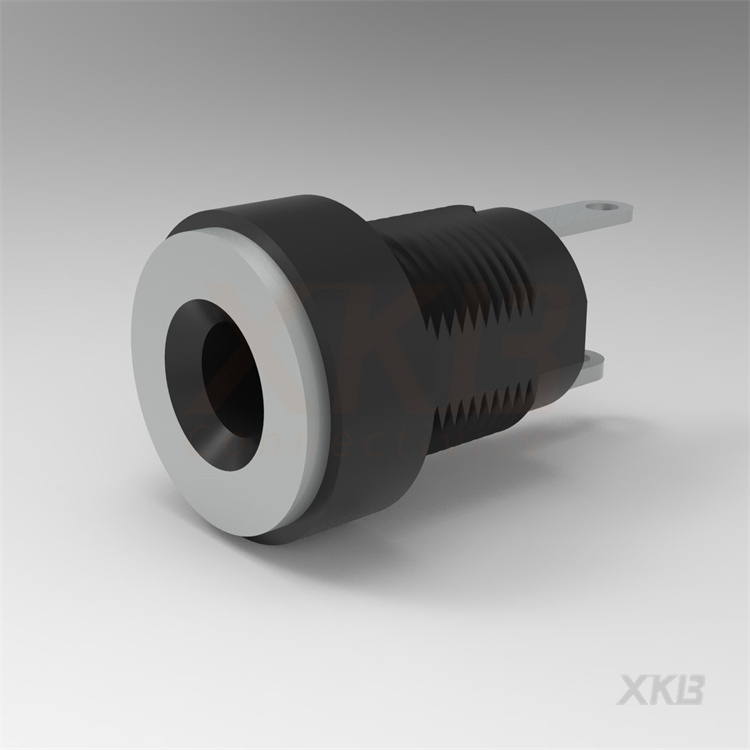Your Cyclopedia: Barrel Power Connector
A technician is tasked with powering a new gadget using a barrel power connector. He carefully selects the appropriate power supply, ensuring it outputs 5 VDC, as many of the workshop's devices are designed specifically for this voltage to prevent damage. He picks up the barrel plug, noting its cylindrical shape, and aligns it with the jack. After a brief moment of hesitation, he successfully inserts the plug, confirming the orientation is correct. With a satisfying click, the gadget powers on, illuminating its LED indicators.
It seems like a mystery but the principle behind it lies in common barrel connector sizes, which you have to consider before a task.
Understanding barrel connectors
A barrel connector, often referred to as a barrel jack or coaxial power connector, is a cylindrical electrical connector widely utilized in electronic devices for power transmission. It is made up of a hollow, cylindrical metal pipe featuring an inner conductor and an outer conductor divided by an insulating layer. The inner conductor usually carries the positive voltage, whereas the outer conductor acts as the ground. This design provides a dependable and compact method for supplying power to different electronic components.
Barrel connectors are available in numerous sizes and specifications, with the most prevalent diameters being 5.5mm and 2.1mm. The size of the connector is essential since it must align with the appropriate plug for a stable and effective connection. These connectors are commonly utilized in devices like power adapters, security cameras, audio gear, and numerous other electronic gadgets.
The construction of the barrel connector provides an easy and effective method for linking and unlinking power sources, which has made it a favored option for consumer electronics and industrial machinery. Moreover, its small size and standardized measurements render it a flexible choice for various devices.
Grasping the fundamentals of the barrel connector is vital for anyone involved with electronic devices, since it is key in supplying power to different components. The upcoming section will explore the various kinds of barrel connectors that exist and their individual uses.

Barrel Power Connector
Types of Barrel Connectors
Barrel connectors are available in different types and sizes to meet the varied requirements of electronic devices and equipment. Recognizing the form of barrel connectors is crucial for choosing the right connector for a particular application. These are the typical kinds of barrel connectors:
Standard Barrel Connectors: These are the most widely utilized barrel connectors and come in various sizes, with 5.5mm and 2.1mm being the most common. They find extensive use in consumer electronics, power adapters, LED lighting, and audiovisual devices.
Right-Angle Barrel Connectors: These connectors have a right-angled configuration, enabling space-saving connections in devices with restricted clearance. They are frequently utilized in small electronic devices where a straight connector might not fit correctly.
Screw-On Barrel Connectors: These connectors feature a threaded design that enables a secure connection, making them ideal for situations where vibration or motion might loosen a regular connector. They are frequently utilized in industrial machinery and outdoor devices.
Waterproof Barrel Connectors: Made for enduring contact with moisture and environmental factors, waterproof barrel connectors are frequently utilized in outdoor security cameras, LED outdoor lighting, and other equipment needing weatherproof power connections.
Custom Barrel Connectors: In certain instances, custom barrel connectors are created to fulfill particular needs of electronic devices, guaranteeing an accurate and reliable power link. These connectors are designed to meet the specific requirements of specialized tools and devices.
Every variety of barrel connector has a specific function, and comprehending their distinct characteristics is essential for choosing the best option for a specific use. The following section will examine how to determine the appropriate barrel connector for a specific device or piece of equipment.
How to Find the Suitable Barrel Connector
Determining the appropriate barrel connector for a particular device or piece of equipment is crucial for guaranteeing a reliable and effective power connection. Here are the main steps to find the right barrel connector:
Review the Device's Specifications
The user manual or specifications of the device typically contain information regarding the necessary power input, including the type and dimensions of the barrel connector. It is crucial to consult these specifications to identify the appropriate connector for the device.
Assess the Connector's Size
When the device's specifications are not easily accessible, taking measurements of the current connector or power input port can assist in identifying the necessary size of the barrel connector. The barrel's length and the connector's diameter are essential measurements to take into account.
Check the Polarity
Barrel connectors are polarized, which indicates they possess a distinct polarity for both the inner and outer conductors. It is crucial to check the polarity needed by the device, since employing a connector with the wrong polarization can harm the equipment.
Take into Account Unique Needs
Certain devices might have unique needs, like a right-angled connector, a waterproof structure, or a threaded connection. Grasping any specific needs or environmental factors is essential for choosing the appropriate barrel connector.
Seek Expert Advice
If unsure about the proper barrel connector for a particular device, seeking advice from an informed professional or reaching out to the device's manufacturer can offer useful assistance in choosing the right connector.
By following these steps, individuals can accurately determine the appropriate barrel connector for their electronic devices, guaranteeing increased safety and dependable power connection. The next part will explore the typical applications of barrel connectors in different electronic uses.
Applications of Barrel Connectors
Barrel connectors are used in a diverse range of electronic devices and uses because of their adaptability and effectiveness in supplying power. Several typical applications of barrel connectors are listed for you to refer to:
Power Adapters
Barrel connectors are commonly used in power adapters for laptops, routers, and various electronic devices, offering an easy way to connect the power supply to the device.
Security Cameras
Numerous security cameras use barrel connectors for power input, providing a simplified and safe link to the power supply.
Audio Equipment
Amplifiers, speakers, and various audio devices frequently use barrel connectors for power input, allowing for a dependable and uniform connection approach.
LED Lighting
LED light fixtures and strips typically utilize barrel connectors, allowing for simple installation and power connectivity across different lighting scenarios.
Electronic Devices
Compact electronic devices like portable gaming consoles, electronic toys, and music players frequently rely on barrel connectors for their power supply, providing a space-saving and effective power connection option.
Industrial Equipment
A range of industrial equipment, such as control systems, sensors, and monitoring devices, utilize barrel connectors for power input, ensuring a standardized and dependable power interface.
These instances show the varied uses of barrel connectors in consumer electronics, industrial machinery, and additional electronic devices. The forthcoming segment will examine the benefits of utilizing barrel connectors in electronic applications.
Advantages of Using Barrel Connectors
Barrel connectors provide numerous benefits, making them a favored option for power connections in electronic gadgets and machinery. Several important benefits of utilizing barrel connectors are:
Standardization
The extensive adoption of barrel connectors has resulted in standardization, simplifying the process for consumers and manufacturers to guarantee compatibility between power supplies and electronic devices.
Compact Design
Barrel connectors feature a small and space-saving design, making them ideal for use in compact electronic devices and scenarios where space is constrained.
Simple Connection and Disconnection
The structure of barrel connectors facilitates straightforward and rapid connection and disconnection, offering ease during installation, upkeep, and problem-solving.
Flexibility
Barrel connectors are available in multiple sizes and styles, providing flexibility to meet diverse power needs and environmental situations, including angled connectors and waterproof options.
Dependability
When appropriately paired with the right plug, barrel connectors deliver a dependable and tight power link, reducing the likelihood of power disruptions or loose connections.
Efficiency
The straightforward design of barrel connectors enhances the effectiveness of power connections, minimizing the time and effort needed for the installation and upkeep of electronic devices and machinery.
The advantages listed above highlight the importance of barrel connectors in offering a consistent, dependable, and effective method for supplying power to electronic devices in diverse applications. The next part will discuss the possible drawbacks of utilizing barrel connectors in electronic applications.
Disadvantages of Using Barrel Connectors
Although barrel connectors provide various advantages, they also have specific drawbacks that need to be taken into account when assessing their implementation in electronic applications. Certain main drawbacks of utilizing barrel connectors consist of:
Polarity Sensitivity
Barrel connectors are designed with polarization, indicating they possess a designated polarity for both the inner and outer conductors. If hooked up improperly, it may cause harm to the device or equipment.
Compatibility Challenges
Even with standardization, compatibility challenges can occur when utilizing barrel connectors, particularly with non-standard or custom-made connectors that might not be easily obtainable.
Durability Issues
In some cases, barrel connectors might be prone to damage, particularly in high-vibration settings, which could result in unstable connections or early malfunction.
Environmental Constraints
Conventional barrel connectors might not be appropriate for severe environmental conditions, necessitating extra shielding or specialized waterproof connectors for outdoor or industrial use.
Space Limitations
In situations where space is restricted, the dimension of the barrel connector can present difficulties, requiring different options for power connections.
Challenges in Personalization
Creating tailored barrel connectors for specific uses can be intricate and often leads to increased expenses and extended waiting periods when compared to standard options.
Learning these disadvantages is important for making wise choices about the implementation of barrel connectors in electronic gadgets and machinery. By thoughtfully assessing the pros and cons, individuals can evaluate the appropriateness of barrel connectors for particular uses and address possible issues related to their application.
Dimensions of Barrel Connectors
You need to consider the barrel power connector size in your work.
While a standard clearance has not been established, the inner sleeve diameter that connects with the inner pin ought to be a bit larger than that of the corresponding pin. Regarding the outer sleeve and the mating connector, the gap is not essential for the connector's proper functioning since the mating connection to the outer sleeve features a cantilevered flat spring.
Along with the diameters of the inner pin and outer sleeve, the depth of insertion is another specification for DC power connectors to consider. A designer may frequently discover that the depth of jack insertion is shorter than the length of the plug barrel. This is due to the necessity of considering the thickness of the chassis wall in specific setups.
If the extra depth is not considered, the barrel length could be insufficient to correctly connect to the jack during the installation. In situations where the plug barrel does not need to be entirely enclosed while being inserted into the jack, a barrel length greater than the insertion depth ratio is permissible.
Mounting Options on Barrel Connectors
Similar to various components, there are multiple choices for attaching a DC power jack to a final application.
Panel mount DC power jacks provide the flexibility of installation at any location on the product chassis, but require wires for connection to the electronic circuitry. For PCB mounted DC power jacks, the most common types are surface mount (SMT) and through-hole, available in both horizontal and vertical orientations.
Several DC power jacks featuring SMT signal connections will additionally provide through-hole pins or tabs to enhance the jack's stability on the PCB. These tabs might or might not be electrically linked but will be soldered to the PCB via through-holes.
Other types of stabilization pins are non-conductive and fit tightly into holes in the PCB. Mid-mount SMT DC power jacks represent an alternative where the jack is positioned in a cutout on the PCB, resulting in a more compact solution for applications with limited space.
Low Voltage DC Power Connectors
Low voltage DC power connectors are essential parts in many electronic devices, offering a dependable way to transfer power from an external source to the device's internal systems. These connectors are especially crucial in situations where compactness, lightweight design, and simple connectivity are vital. Grasping the various kinds and specifications of low voltage DC power connectors can help designers and engineers choose the appropriate components for their projects.
Common Sizes for Low Voltage Barrel Connectors
Barrel connectors are often classified by their dimensions, mainly based on the inner diameter of the barrel (the central pin's diameter) and the outer diameter of the connector body. Typical barrel connector sizes generally span from 2.1mm to 5.5mm in outer diameter, while the inner diameters tend to be marginally smaller. Here are several typical types:
2.1mm: This size is frequently employed in low voltage scenarios, typically seen in gadgets such as routers and cameras.
2.5mm: A bit bigger, this connector can handle a greater current, which makes it ideal for devices like small speakers or portable gear.
3.5mm: Less prevalent but utilized for high-power uses where a greater current flow is required.
5.5mm: Generally employed for bigger devices or those that need higher voltage, like laptops and consumer electronics.
Understanding Polarity
A crucial component of low voltage DC power connectors is polarity, which denotes the positive and negative ends of the connector. The majority of barrel connectors adhere to a standard polarity, where the central pin is positive and the outer sleeve is negative. It is essential to confirm the polarity specifications of the particular device to prevent possible damage.
Certain connectors are also equipped with markings or color codes to show their polarity, facilitating straightforward identification while installing. Producers frequently offer specifications that outline the appropriate polarity to avoid connection mistakes.
Current and Voltage Ratings
Low voltage DC power connectors have designated voltage and current ratings that determine their appropriateness for different uses. Designers must take these ratings into account to guarantee proper performance and safety. The majority of low voltage barrel connectors manage output voltage levels between 5V and 30V, featuring current ratings that can range from a few hundred milliamps to multiple amps.
Grasping these ratings aids in accurately aligning the connector with the device’s requirements while also preventing overheating or malfunction. When utilizing connectors near the upper limits of their current ratings, take into account heat dissipation strategies to extend the connector's lifespan.
Application Areas
Low voltage DC power connectors are commonly used in various applications, such as:
Consumer Electronics: Gadgets such as digital cameras, portable speakers, and electronic toys frequently utilize low voltage barrel connectors for power supply and charging.
Computers and Peripherals: Numerous accessories, including external hard drives and routers, depend on these connectors for energy.
Industrial Equipment: In automation, machine controllers and sensors frequently utilize low voltage DC connectors to guarantee dependable power supply.
DIY Projects: Hobbyists and creators often use low voltage barrel connectors in personalized electronics endeavors, providing simple connections for battery packs or power sources.
Connector Gender
Definition
Plug-type connectors are usually categorized into two sections known as male and female, often described as the connector's gender. The male connector, referred to as the plug, features a solid central contact. The female connector may also be referred to as the socket, and its center contact is hollow, featuring openings that can hold male pins. Once the male connector is fitted into the female connector and secured via threading, bayonet, or similar methods, it can transmit both electric current and data. But not all connectors have male or female.
Advantages of Defining Male And Female Connectors
1. Simplifies the manufacturing process and large-scale production of electronic items.
2. Allows for rapid substitution of malfunctioning electronic components when connectors are utilized.
3. Enables upgrades. As technology evolves, connectors enable the substitution of outdated components with more modern and sophisticated alternatives.
4. Improves design adaptability, allowing engineers more latitude in creating and integrating new products, along with assembling systems with diverse components.
Contact Material of Male And Female Connector
Since the male and female connectors are utilized for current and data transfer, and aluminum and copper are the most common materials employed to manufacture the male and female pins of connectors, what are the pros and cons of aluminum and copper?
Aluminum exhibits excellent electrical conductivity, approximately twice that of copper; however, its resistivity is significantly greater than that of copper, indicating that its capacity to conduct electricity is considerably inferior to that of copper. Moreover, the resistivity of aluminum rises as temperature increases, indicating that its capacity to conduct electricity diminishes with higher temperatures.
Copper exhibits excellent electrical conductivity, surpassing aluminum in conductivity, while its resistivity is lower than that of aluminum, indicating it conducts electricity more effectively than aluminum. Furthermore, the resistivity of copper declines as temperature rises, indicating that its capacity to conduct electricity improves with higher temperatures.
Typically, for high-demand connectors, copper is selected as the contact material for both male and female components, as gold plating on copper enhances its electrical conductivity. Copper is an effective conductive material; however, there are situations where the conductivity of copper contacts might be influenced. In environments such as high temperature, high humidity, and high altitude, the resistivity of copper can rise, leading to power loss and energy waste. Once the copper is coated with gold, a metal film layer can be created. The metal film possesses excellent electrical conductivity, enhancing the conductivity of the copper contact, lowering resistivity, and minimizing power loss and energy waste.
Gold is applied to copper conductors to enhance their resistance to corrosion. Copper wires are susceptible to oxidation and corrosion in humid, acidic, alkaline, and various other conditions, leadingto the copper surface turning black, becoming fragile, and potentially resulting in the wire breaking. Once the copper contacts are coated with gold, the metallic layer can serve a specific anti-corrosion function, safeguarding the copper wires from degradation and prolonging their lifespan.
Conductor Configurations
Grasping the different setups of barrel power connectors is vital for guaranteeing compatibility and peak performance in electrical systems. Barrel connectors, often referred to as cylindrical connectors or DC power connectors, are characterized by their distinct design that includes a cylindrical housing with an inner contact pin and an outer sheath. The arrangement can greatly influence the way power is supplied and the dependability of the connection.
Common Sizes of Barrel Connectors
Barrel connectors exist in various sizes, each appropriate for distinct uses. The dimensions of a barrel connector are usually indicated by its outer diameter (OD) and inner diameter (ID). Typical dimensions consist of:
2.1mm x 5.5mm: This size is commonly utilized, frequently seen in consumer devices such as laptops and cameras. Its sleek design enables a secure fit while providing dependable power.
2.5mm x 5.5mm: This size is a bit larger than the 2.1mm connector and is often used for devices that need higher current, like routers and certain power adapters.
3.5mm x 1.35mm: This compact size is commonly found in portable gadgets and is perfect for devices that do not need substantial power. It is commonly utilized for devices like portable consoles and smaller battery-powered gadgets.
4.0mm x 1.7mm: Commonly used in scenarios that require higher power transmission, like larger cameras and scientific devices, this connector supports more durable wiring.
Voltage and Current Ratings
Besides their size, barrel connectors also possess unique voltage and current specifications. The ability of a barrel connector to manage current is vital for avoiding overheating and guaranteeing safe function. The majority of connectors are rated for standard voltages between 5V and 24V, although connectors for higher voltages can be found for specific applications. When choosing a barrel connector, always refer to the specifications to confirm it can support the required load.
Polarity
An additional factor to take into account in barrel connector setups is polarity. Barrel connectors can be center-positive or center-negative, indicating whether the inner pin (the positive contact) or the outer sleeve (the negative contact) holds the positive voltage. It is crucial to use the proper polarity to prevent harm to electronic devices. Numerous connectors feature symbols to show their polarity, simplifying the process for users to safely link their devices.
Applications of Barrel Connectors
Barrel connectors find use in a wide range of electronic applications. Devices in high demand, such as laptops and televisions, need dependable and steady power connections, which is why barrel connectors are frequently selected. They are frequently located in:
Charging Stations: Numerous portable gadgets use barrel connectors for their charging stations because of their reliability and convenience.
Power Adapters: The versatile nature of barrel connectors enables their incorporation into multiple power adapters, accommodating diverse voltage and current needs.
LED Lighting: As LED technology advances, barrel connectors are becoming more common in lighting solutions to provide effortless and reliable power supply.
Compatibility Considerations
When integrating barrel connectors into electronic systems, compatibility is a critical aspect to ensure effective and safe operation. Here are several key points to take into account:
Connector Size and Shape
The dimensions and configuration of the barrel connector are crucial in establishing compatibility with power sources and devices. As stated earlier, the usual dimensions consist of 2.1mm x 5.5mm, 2.5mm x 5.5mm, 3.5mm x 1.35mm, and 4.0mm x 1.7mm. It's crucial to align the connector exactly with the device port, because a connector that is overly loose can cause intermittent connections, whereas one that is excessively tight might harm either the connector or the device port. Always check measurements and standards before choosing a connector when replacing or buying a new one.
Voltage Ratings
Although the physical dimensions of the connector are important, it is just as vital to align the voltage rating of the connector with that of the device. Employing a barrel connector rated for a voltage lower than what the device needs may result in malfunctions, overheating, or even potential fire risks. Always refer to device specifications to choose a suitable connector.
Current Ratings
Along with voltage, the current rating of a barrel connector is essential. Every connector is engineeredto manage a particular maximum current load, usually detailed in the technical specifications. Surpassing this threshold may lead to overheating, presenting a significant risk of malfunction or harm. Verify that the current rating of the barrel connector matches or surpasses the requirements of the device it powers.
Polarity Matching
As mentioned in the previous section about polarity, incorrect positive and negative connections can harm electronic devices. Regularly checking visually for polarity indicators on both the power source and the device is important. It is crucial to ensure that the barrel connector is properly aligned with the correct polarity for safe and efficient functioning.
Environmental Considerations
Various applications might pose distinct environmental issues. For example, connectors utilized in outdoor gear might need strong sealing to safeguard against moisture and dirt. In the same way, when the device functions in extreme temperatures, it is essential to choose connectors that are rated for those environments. Make sure that the connectors you select are appropriate for the operational environment of your equipment.
USB Connectors
USB (Universal Serial Bus) is a standard used for linking devices and sharing data. It allows for communication, charging, and data transfer among devices such as keyboards, mice, smartphones, and printers. In practice, USB connector is available in various connector types, including USB-A, USB-B, USB Mini, USB Micro, and USB-C. In this guide, we will explain the distinctions among these USB types and provide helpful advice for purchasing USB cables.
USB Connector Types
USB Type-A
One end of the majority of USB cables features a type-A connector. This is a widely used kind of USB connector that can be found on computers, printers, chargers, and more.
Usually, it features a black rectangular connector that is predominantly utilized for data transmission adhering to USB 2.0 specifications. Nonetheless, the connector may be blue and red for the USB 3.0 and USB 3.2 specifications. One end of each USB cable features a type-A connector designed for linking an IT peripheral to a computer.
USB Type-B
USB Type-B has a square design and is primarily utilized for devices such as printers, scanners, and external hard drives. It is not as prevalent in consumer electronics but is frequently utilized in bigger devices that need faster data transfer speeds.
USB Micro-B
Micro-B is a small 5-pin connector frequently found in compact electronics such as older smartphones, power banks, and game controllers.
The micro-B connector is utilized for establishing a data link between a computer and these compact digital devices. It is also utilized to transfer energy to the smartphone’s battery using a charger. The micro-B USB remains prevalent in low-cost Android smartphones lacking a USB-C port.
USB Mini-B
Mini-B is slightly bigger than Micro-B yet smaller than Type-B. It was frequently utilized for digital cameras, certain smartphones, and portable music devices.
Mini-B USB connectors are utilized for charging and data transfer, but they are slowly being substituted by Micro-B and Type-C connectors, which offer smaller sizes and improved performance.
USB Type-C
You should be aware of what a USB-C port is, as it is the most prevalent connector currently. USB-C charging represents the latest standard in USB technology. It is commonly present in smartphones, contemporary laptops, tablets, power banks, and more.
USB-C has a 24-pin reversible connector, allowing you to insert it in either direction. Additionally, USB-C provides data transfer rates of up to 20Gbps. Explore our range of Anker USB C chargers that can quickly charge your smartphones, laptops, power banks, and chargers in a safe and convenient manner.
USB Purchase Precautions
USB Type
Prior to purchasing a cable for yourself, determine the type and version of USB you wish to acquire. As mentioned earlier, cables may feature various types of USB connectors. You cannot power any USB C device directly using a USB Type B cable, for instance. Locate the USB cables that have the appropriate connectors for your devices.
Producer
Always purchase USB cables from trustworthy manufacturers exclusively, as they use top-notch materials to create a cable.
Certification
Verify the safety certifications of a USB cable before making a purchase. These certifications guarantee that the cable is safe for use in typical situations without the threat of fire, short-circuit, or electric shock. These safety certifications are provided to manufacturers by the government. And do not forget to check the shipping option.
Build Type
Rubber USB cables are prevalent, but they experience environmental wear and tear as time progresses. You can also purchase braided USB cables since they are more durable and better at resisting kinks and twists.
Conclusion
Learning the sizes of barrel power connectors is crucial for choosing the appropriate connectors for your devices. Offering various sizes, they address diverse power needs and connection requirements. Choosing appropriately not only guarantees compatibility but also improves the durability and efficiency of your electronics. As technology advances, keeping abreast of the newest standards allows users to make informed choices, especially with new connectors such as USB-C that provide unique benefits in power and data transmission.
In conclusion, whether you're powering an advanced laptop or charging a digital camera, understanding barrel connector specifications will assist you in maneuvering through the extensive world of technology effortlessly. Always emphasize quality, compatibility, and safety when choosing your power connectors to guarantee optimal performance and dependability.




















